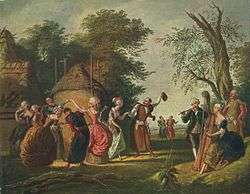Polonaise
The polonaise (/pɒləˈneɪz/, French: [pɔlɔnɛz]; Polish: polonez) is a dance of Polish origin,[2] in 3
4 time. Its name is French for "Polish."
The polonaise has a rhythm quite close to that of the Swedish semiquaver or sixteenth-note polska, and the two dances have a common origin.
The polonaise is a widespread dance in carnival parties. The polonaise is always a first dance at a studniówka ("hundred-days"), the Polish equivalent of the senior prom that occurs approximately 100 days before exams.
 Polish Noblemen dancing Polonaise, painting by Jan Piotr Norblin
Polish Noblemen dancing Polonaise, painting by Jan Piotr Norblin Poles dance Polonez, painting by Korneli Szlegel
Poles dance Polonez, painting by Korneli Szlegel Chopin's Polonaise - a Ball in Hôtel Lambert in Paris.
Chopin's Polonaise - a Ball in Hôtel Lambert in Paris.
Influence of Polonaise in music
The notation alla polacca (Italian: polacca means "polonaise") on a musical score indicates that the piece should be played with the rhythm and character of a polonaise. For example, the third movement of Beethoven's Triple Concerto op. 56, marked "Rondo alla polacca," and the finale of Chopin's Variations on "Là ci darem la mano" both feature this notation. In his book Classic Music: Expression, Form, and Style, Leonard G. Ratner cites the fourth movement from Beethoven's Serenade in D major, Op. 8, marked "Allegretto alla Polacca," as a representative example of the polonaise dance topic (Ratner 1980, pp. 12–13).
Frédéric Chopin's polonaises are generally the best known of all polonaises in classical music. Other composers who wrote polonaises or pieces in polonaise rhythm include Johann Sebastian Bach, Georg Philipp Telemann, Wilhelm Friedemann Bach, Carl Philipp Emanuel Bach, Wolfgang Amadeus Mozart, Ludwig van Beethoven, Ferdinand Ries, Michał Kleofas Ogiński, Karol Kurpiński, Józef Elsner, Niccolò Paganini, Maria Agata Szymanowska, Franz Schubert, Vincenzo Bellini, Louis Spohr, Carl Maria von Weber, Robert Schumann, Franz Liszt, Henryk Wieniawski, David Popper, Wojciech Kilar, Johann Kaspar Mertz, Moritz Moszkowski, Friedrich Baumfelder, Ferdinando Carulli, Mauro Giuliani, Modest Mussorgsky, Nicolai Rimsky-Korsakov, Pyotr Ilyich Tchaikovsky and Alexander Scriabin.
Another more recent prolific polonaise composer was the American Edward Alexander MacDowell.
John Philip Sousa wrote the Presidential Polonaise, intended to keep visitors moving briskly through the White House receiving line. Sousa wrote it in 1886 at the request of President Chester A. Arthur who died before it was performed.[3]
Tchaikovsky's opera Eugene Onegin, an adaption of Alexander Pushkin's novel in poetry verse, includes a famous polonaise.
National dance
The polonaise is a Polish dance and is one of the five historic national dances of Poland.[4] The others are the Mazurka (Mazur), Kujawiak, Krakowiak and Oberek, last three being old folk dances.[5] Polonaise originated as a peasant dance known under various names – chodzony ("pacer"), chmielowy ("hops"), pieszy ("walker") or wielki ("great"), recorded as early as the 15th century. In later centuries it gained popularity among the nobility and townspeople.[6][7]
Polonaise in French Courts
The polonaise or polonez, was first introduced in the 17th century in French courts, although the form originated in Poland and was very popular throughout Europe. This dance in 3/4 meter was designed to entertain the French royal court. The term polonaise was used over the term polonez at the start of the 18th century.
Princess Anna Maria of Saxony
Princess Anna Maria of Saxony collected polonaises throughout her life time, collecting over 350. Her collection was focused on the finest examples of instrumentation.
See also
References
- ↑ Blatter, Alfred (2007). Revisiting music theory: a guide to the practice, p.28. ISBN 0-415-97440-2.
- ↑ Don Michael Randel. The Harvard Dictionary of Music. Harvard University Press. 2003. p. 668.
- ↑ Sousa: Marching Along, p.85 Integrity Press, 1994
- ↑ Polish Folk Music and Chopin's Muzurkas Archived 2011-07-23 at the Wayback Machine.
- ↑ OBEREK (OBERTAS)
- ↑ Roderyk Lange. Tradycyjny taniec ludowy w Polsce i jego przeobrażenia w czasie i przestrzeni. PUNO. 1978. p. 40.
- ↑ Selma Jeanne Cohen. International encyclopedia of dance: a project of Dance Perspectives Foundation, Inc. Oxford University Press. 1998. p. 223.